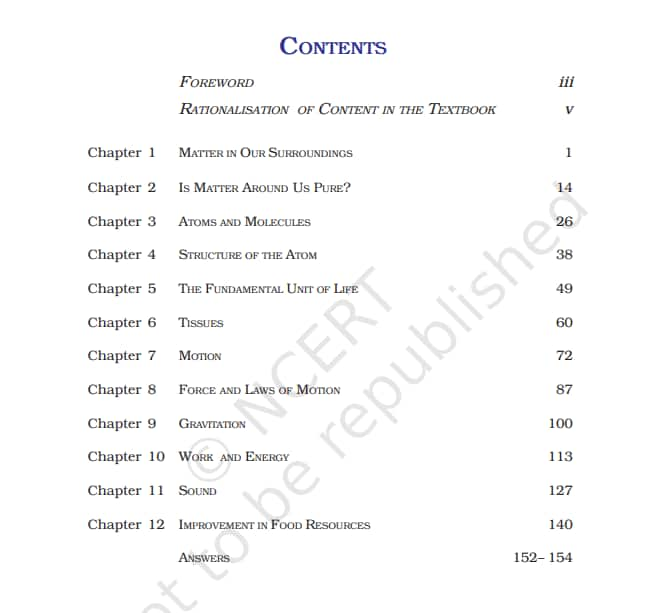NCERT Syllabus for Class 9 Science 2026 - DOwnload Chapter-wise PDF
The National Council of Educational Research and Training (NCERT) has revised the NCERT Syllabus for Class 9 science in line with the National Education Policy (NEP) 2020 and the NCF-SE 2023 framework. This well-structured approach makes the NCERT Class 9 Science syllabus more engaging. From Physics to Biology, the Class 9 NCERT Science Syllabus makes you ready for your academic success. This article will guide you through the topics which are covered in the Class 9 science syllabus. This NCERT syllabus for class 9 science will bring clarity, direction, and purpose to your studies. Students can use NCERT books, which are aligned with the latest syllabus, for a clear understanding.
This Story also Contains
- NCERT Syllabus for Class 9 Science: Complete Breakdown
- NCERT Syllabus for Class 9 Science - Physics
- NCERT Syllabus for Class 9 Science - Chemistry
- NCERT Syllabus for Class 9 Science- Biology
- Class 9 Science Subject NCERT Book Index
- Benefits of Knowing the NCERT Science Class 9 Syllabus
- CBSE Class 9 Science: Chapter-wise Marks Distribution 2026
- NCERT Solutions for Class 9 Science
- NCERT Class 9 Science Subject: Preparation Materials

NCERT Syllabus for Class 9 Science: Complete Breakdown
The Class 9 NCERT Science Syllabus is divided into three major areas:
Physics: Focuses on chapters like motion, force, gravitation, sound, and energy.
Chemistry: Includes chapters related to matter, atoms, and molecules.
Biology: Covers chapters on the cell, tissues, and food resources.
NCERT Syllabus for Class 9 Science - Physics
The NCERT Class 9 Physics syllabus helps you understand the laws that govern the world around you, one concept at a time. Here is a brief preview of what is to be learned this year.
| Chapter | Topics |
| Chapter 1: Motion | Describing Motion |
| Equations of Motion by Graphical Method | |
| Graphical Representation of Motion | |
| Measuring the Rate of Motion | |
| Rate of Change of Velocity | |
| Uniform Circular Motion | |
| Chapter 2: Force and Laws of Motion | Conservation of Momentum |
| Force | |
| Newton's First Law of Motion | |
Newton's Third Law of Motion | |
| Chapter 3: Gravitation | Archimedes' Principle |
| Gravitation | |
| Mass and Weight | |
| Chapter 4: Work and Energy | Kinetic and Potential Energy |
Law of Conservation of Energy | |
| Work and Power | |
| Chapter 5: Sound | |
Production and Propagation of Sound | |
Range of Hearing and Ultrasound | |
| Reflection of Sound | |
| The Human Ear |
NCERT Syllabus for Class 9 Science - Chemistry
Chemistry comes alive with the Class 9 NCERT syllabus, connecting classroom learning with real-world experiments. Here are the chapters along with the topics students will learn in Class 9.
| Chapter | Topics |
| Chapter 1: Matter in Our Surroundings | - Evaporation - Matter – An Introduction - States of Matter and Their Interconversion |
| Chapter 2: Is Matter Around Us Pure | - Centrifugation and Chromatography - Elements and Compounds - Mixtures - Physical and Chemical Changes - Separation of Mixtures |
| Chapter 3: Atoms and Molecules | - Atoms - Chemical Formulae - Laws of Chemical Combination - Mole Concept - Molecules |
| Chapter 4: Structure of the Atom | - Atomic Models - Charged Particles of an Atom - Isotopes and Isobars |
NCERT Syllabus for Class 9 Science- Biology
From tissues to food resources, the Class 9 Biology syllabus builds the foundation for your journey in life sciences. Here is a brief overview of the journey of biology in class 9.
| Chapter | Topics |
| Chapter 1: The Fundamental Unit of Life | - Cell Organelles - Cellular Magic - Comparing Cells and Cell Division - Diffusion and Osmosis - Structure of the Cell |
| Chapter 2: Tissues | - Epithelial and Connective Tissue - Muscular Tissue and Nervous Tissue - Plant Tissues |
| Chapter 3: Improvement in Food Resources | - Cattle Farming - Crop Production Management - Crop Protection Management - Fishery and Apiculture - Improvement in Crop Yields - Poultry Farming |
 Class 9 Science Subject NCERT Book Index
Class 9 Science Subject NCERT Book Index
Benefits of Knowing the NCERT Science Class 9 Syllabus
Knowing the Class 9 NCERT Science Syllabus helps students plan their studies more effectively and manage their time better. Here are some other benefits of this syllabus article.
- With a clear outline of all the chapters and subtopics, students can divide their workload and focus on completing each part without last-minute stress.
- It also gives clarity on which topics are most important, helping them prioritise their efforts during preparation and revision.
- Being familiar with the syllabus ensures that students stay aligned with the latest guidelines and don’t waste time on topics that aren’t required.
- Practical work is a part of the curriculum; knowing the syllabus helps track practical-based chapters and plan for experiments in advance, making preparation more complete and organised.
CBSE Class 9 Science: Chapter-wise Marks Distribution 2026
Total number: 100
- Theory (Written Exam): 80 marks
- Internal Assessment: 20 marks
To complete the theory exam, students will get 3 hours. Here is the expected marks distribution chapter-wise, prepared by our experienced faculty at Careers360.
Unit | Chapter | Chapter Name | Expected Marks |
I | 1 | Matter in Our Surroundings | 6 |
2 | Is Matter Around Us Pure? | 6 | |
3 | Atoms and Molecules | 6 | |
4 | Structure of Atoms | 7 | |
II | 5 | The Fundamental Unit of Life | 6 |
6 | Tissues | 6 | |
III | 7 | Motion | 6 |
8 | Force and Laws of Motion | 6 | |
9 | Gravitation | 6 | |
10 | Work and Energy | 5 | |
11 | Sound | 4 | |
IV | 12 | Improvement in Food Resources | 6 |
In the internal assessment test, the following activities are done:
- Periodic Tests: 5 marks
- Multiple Assessments: 5 marks
- Practical Work: 5 marks
- Portfolio: 5 marks
NCERT Solutions for Class 9 Science
Access all NCERT Class 9 Science solutions from one place using the links below.
NCERT Class 9 Science Subject: Preparation Materials
Students in Class 9 can utilise a variety of preparation resources to strengthen their Science understanding and perform better in exams. Most crucial preparation resources are the NCERT textbook, which strictly adheres to the NCERT syllabus, and the NCERT Exemplar, which provides additional questions for in-depth practice. Reference books are useful for understanding hard topics more easily. Sample papers or previous years' papers provide students with a better view of the exam patterns, commonly used concepts, and frequently asked questions. Online learning platforms incorporate interactive videos, quizzes, and mock tests to make learning more engaging.
| Resource Type | Description |
| NCERT Textbooks | Core learning material, as per the CBSE syllabus, must be studied thoroughly. |
| NCERT Exemplar | Provides additional practice questions for deeper understanding. |
| Reference Books | Gain a deeper understanding of complex topics with extra explanations and practice. |
| Sample Papers | Useful for understanding question patterns and practising time management. |
| Previous Year Papers | Gives an idea of commonly asked questions and exam trends. |
| Online Learning Platforms | Offer video lessons, quizzes, and mock tests for interactive learning. |
Frequently Asked Questions (FAQs)
The Class 9 Science syllabus for 2026 includes three core subjects: Physics, Chemistry, and Biology. Each subject covers important concepts like motion, gravitation, atoms, the cell, tissues, and ecosystems, combining both theoretical and practical learning.
No, it is moderate and concept-based. Regular reading, understanding diagrams, and practising NCERT questions make it manageable.
Absolutely. Many Class 10 concepts, such as chemical reactions, heredity, electricity, and classification, are built upon the basics learned in Class 9.
Understanding the syllabus helps students plan their studies better by organising their topics, managing their time efficiently, and focusing on the most important areas. It also ensures they stay aligned with the various boards, such as CBSE requirements, and prepare properly for practical assessments.
Many educational platforms, such as Careers360, offer free downloadable PDFs of the Class 9 Science Syllabus. Students can download the PDF for free from this article itself.
The updated syllabus PDF is available for free on the NCERT official website.
The Physics syllabus includes five main chapters: Motion, Force and Laws of Motion, Gravitation, Work and Energy, and Sound. Key topics include Newton’s Laws, conservation of momentum and energy, types of motion, sound waves, and the human ear.
Students should primarily study NCERT textbooks, as they follow the latest syllabus. For extra practice, NCERT Exemplar books, reference books, sample papers, previous year papers, and online learning platforms with videos and quizzes can be very helpful.
Students are expected to understand and apply practical concepts, especially in experiments related to chapters like Motion, Sound, and Matter. The syllabus encourages hands-on learning, so being familiar with practical chapters helps in preparing for lab work and practical exams.
Popular Questions
Courses After 12th
Applications for Admissions are open.
As per latest syllabus. Physics formulas, equations, & laws of class 11 & 12th chapters
JEE Main Important Chemistry formulas
Get nowAs per latest syllabus. Chemistry formulas, equations, & laws of class 11 & 12th chapters
JEE Main high scoring chapters and topics
Get nowAs per latest 2024 syllabus. Study 40% syllabus and score upto 100% marks in JEE
JEE Main Important Mathematics Formulas
Get nowAs per latest syllabus. Maths formulas, equations, & theorems of class 11 & 12th chapters
